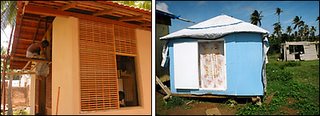 Several years ago, I attended a talk by the late Sam Mockbee with my brother. Mockbee ran the innovative Rural Studio at Auburn University, a project whereby architecture students built affordable, well-designed housing for people living in Alabama's--and the country's--poorest areas. I recall him saying something like: Habitat for Humanity is great, but would you want to live in one of those houses? "Everybody wants the same thing, rich or poor ... not only a warm, dry room, but a shelter for the soul," he once said.
Several years ago, I attended a talk by the late Sam Mockbee with my brother. Mockbee ran the innovative Rural Studio at Auburn University, a project whereby architecture students built affordable, well-designed housing for people living in Alabama's--and the country's--poorest areas. I recall him saying something like: Habitat for Humanity is great, but would you want to live in one of those houses? "Everybody wants the same thing, rich or poor ... not only a warm, dry room, but a shelter for the soul," he once said.Mockbee died too young, from leukemia, in 2001. But his thinking is being carried on: tomorrow at the TED (Technology Entertainment Design) conference, architect Cameron Sinclair will be given $100,000 to make a "wish" come true. And given his work in founding Architecture for Humanity (AFH), it's a safe bet he'll use it to continue building temporary housing for victims of war and disaster in places like Louisiana, Serbia, earthquake-struck Pakistan, and areas devastated by the Southeast Asian tsunami in 2004. (Here's a list of AFH projects.)
 In a profile of Sinclair, The Christian Science Monitor describes his grad-school project: "[H]e designed temporary housing for New York's homeless that would obscure the view of the Statue of Liberty. His proposal: Once the city could properly house its 'huddled masses,' it could have its view of the lady with the lamp back." Born in Scottland and based in Montana (but currently teaching at the University of Minnesota), Sinclair has a motto that guides his work--"design with pride, not pity." And some of his methods reflect those values:
In a profile of Sinclair, The Christian Science Monitor describes his grad-school project: "[H]e designed temporary housing for New York's homeless that would obscure the view of the Statue of Liberty. His proposal: Once the city could properly house its 'huddled masses,' it could have its view of the lady with the lamp back." Born in Scottland and based in Montana (but currently teaching at the University of Minnesota), Sinclair has a motto that guides his work--"design with pride, not pity." And some of his methods reflect those values:• He refuses to reveal the locations of AFH projects to television news crews. The story should be "What do we need to do to allow this community to rebuild?' " he says, but too often TV crews' attitude is "let's see some suffering."Keep up with the TED conference at TEDblog.
• Plans for a building or other structures developed for AFH are available to anyone - for free. "Any nonprofit can come to us and ask, 'Can we have the construction documents for that project you did?" he says. "[And we say,] 'absolutely!' "
• AFH won't put signs with its name or that of donors on a project it builds. The building, Sinclair says, belongs to the community, not AFH or the donors. "If you donated to our organization, you know you built it, I know you built it," Sinclair says. "Why do you need to force it down their throats?"
• AFH doesn't rush in after a disaster. "We shouldn't be there in the first day or to. That's inappropriate. That's really offensive to communities," he says, whose first needs are food, clothing, and information about family members. "The idea that an architect is this person who flies in, jumps off the plane, and goes to the rescue is just about the worst image possible."
On view: HOME House Project: The Future of Affordable Housing at the Frederick R. Weisman Art Museum, University of Minnesota.
Update: Read an Eyeteeth interview with Sinclair here.
Photos: Rural Studio's Music Man House" (top); AFH slat-house in Sri Lanka and temporary housing in Grenada.
No comments:
Post a Comment